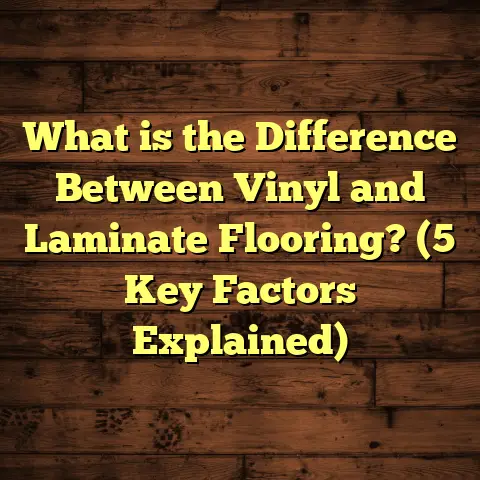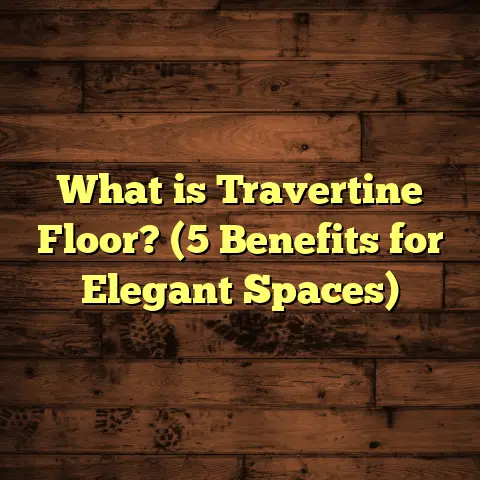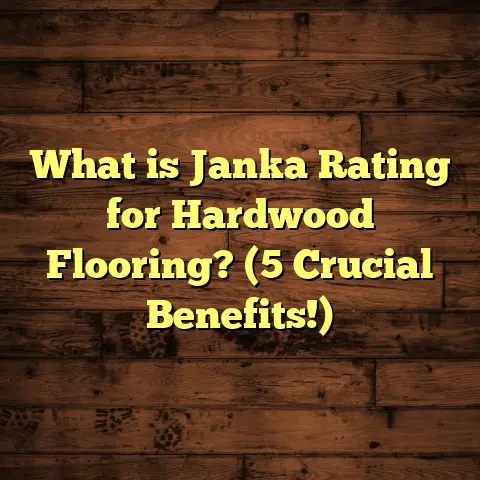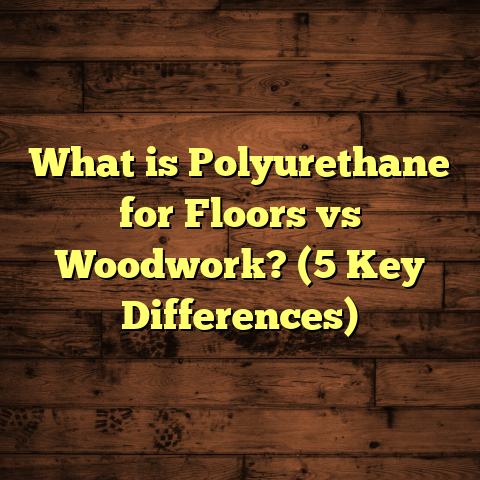What is LVP Flooring Made Of? (5 Key Components Revealed!)
Imagine walking into your home after a long day, and the first thing you notice is the beautiful floor beneath your feet. It looks exactly like rich hardwood but feels warmer and softer when you step on it. No creaking, no cold tiles, just a smooth, durable surface that holds up to everything life throws at it—kids spilling juice, pets scratching, even the occasional dropped tool without leaving a mark. It’s exactly what you wanted: stylish, practical, and affordable. That’s what Luxury Vinyl Plank (LVP) flooring can offer.
I’ve been in the flooring business for over a decade now, and I can tell you firsthand that LVP has revolutionized the way homeowners think about floors. It combines aesthetics with functionality in a way few other materials do. But what is LVP really made of? How does it manage to look like wood yet withstand moisture, scratches, and daily wear so well? Let me walk you through everything I’ve learned about this fantastic flooring option—from its core components to installation tips, maintenance advice, and real-world experiences.
What Is LVP Flooring?
Luxury Vinyl Plank (LVP) flooring is a synthetic flooring product designed to replicate the look and feel of real hardwood floors. Unlike traditional vinyl sheets or tiles, LVP comes in plank form, usually resembling individual wooden boards. This design not only makes it easier to install but also allows for a more authentic wood floor appearance.
LVP belongs to a broader category called resilient flooring. That means it’s designed to “bounce back” from impacts such as dropped objects or foot traffic without permanent damage. It’s thicker and more robust than older types of vinyl flooring and uses advanced technology to mimic natural textures better.
In essence, LVP is a layered product made from different materials that work together to create a floor that looks great, feels comfortable underfoot, and stands up to everyday challenges. Its popularity stems from this unique combination of beauty, durability, water resistance, and affordability.
The 5 Key Components of LVP Flooring
Let’s break down the five main layers that make up LVP flooring. Each layer serves a specific purpose in terms of structure, aesthetics, protection, or comfort.
1. Wear Layer: The Floor’s Shield
The wear layer is the clear top coating that protects everything underneath from scratches, dirt, stains, and fading. Imagine it as a transparent armor sheet laid over the floor.
- Material: Usually made from urethane or aluminum oxide-enhanced urethane.
- Thickness: Measured in mils (thousandths of an inch), typically ranging from 8 mil (0.2 mm) to 30 mil (0.76 mm).
- Importance: The thicker this layer, the more durable your floor will be.
When I started installing floors years ago, I noticed clients with thin wear layers complaining about scratches or dull spots quickly appearing. Now I always recommend at least 12 mil for residential use. For commercial spaces or heavy traffic areas, 20 mil or more is better.
This layer also includes UV protection in many products to prevent color fading when sunlight hits your floor.
2. Printed Design Layer: The Look You Want
Right under the wear layer is where the magic happens visually—the printed design layer. This is a high-resolution image printed onto the vinyl that replicates wood grains, knots, colors, and textures.
- Technology: Advanced photographic printing techniques.
- Variety: From rustic reclaimed wood looks to sleek modern hardwoods or even stone patterns.
- Effect: Provides the authentic visual appeal of natural wood without the cost or maintenance headaches.
When I was helping a family renovate their living room last year, they couldn’t believe how realistic the hickory pattern looked on their new LVP floor. They expected to see “fake” vinyl shine but were amazed at the depth and texture.
3. Core Layer: The Backbone of Durability
The core is what gives each plank its strength and stability. It’s usually made from one of two types of materials:
- Rigid Core: Made from Wood Plastic Composite (WPC) or Stone Plastic Composite (SPC).
- SPC core contains limestone powder mixed with PVC resin for extra hardness.
- WPC core blends wood fibers with plastic for a slightly softer feel.
- Flexible Core: Traditional vinyl sheets without rigid fillers; less common in modern LVP products.
The thickness here varies but usually falls between 4 mm to 8 mm for rigid cores.
From my experience, SPC cores are fantastic in places where moisture is an issue—kitchens, bathrooms, basements—because they don’t swell or warp when wet. WPC cores offer a bit more cushion underfoot but might not handle heavy moisture as well.
4. Backing Layer: Foundation Stability
The backing layer sits beneath the core and stabilizes the entire plank. It acts like a base that keeps the floor flat and prevents warping or curling over time.
- Materials: Could be vinyl-based or include foam or cork for additional comfort.
- Function: Adds dimensional stability and sometimes sound absorption.
Sometimes manufacturers attach an underlayment directly to this backing for convenience during installation.
5. Optional Attached Underlayment: Comfort and Quiet
Not every plank has this layer pre-attached but many modern products do.
- Purpose: Provides cushioning, reduces noise from footsteps, and smooths minor subfloor imperfections.
- Materials: Foam, cork, or rubberized pads.
I love products with attached underlayment because they save time during installation and improve comfort immediately.
Why Is Knowing These Components Important?
Understanding what makes up your LVP floor helps you make smarter choices when shopping or planning your project. For example:
- Want durability for pets? Look for thicker wear layers and SPC cores.
- Need comfort underfoot? Consider WPC cores with attached underlayment.
- Installing in a bathroom? Prioritize waterproofing features and rigid cores.
- Concerned about noise? Choose planks with sound-dampening backing.
This knowledge can also explain why prices vary so much—from budget-friendly options around $2 per square foot to premium floors reaching $7 or more per square foot.
How Does LVP Compare With Other Flooring Types?
I get asked this question all the time by clients stuck deciding between hardwood, laminate, tile, or carpet. Here’s a quick comparison:
| Flooring Type | Durability | Water Resistance | Cost per sq ft | Maintenance | Appearance |
|---|---|---|---|---|---|
| Hardwood | Medium | Low | $5 – $15 | Requires refinishing | Natural wood beauty |
| Laminate | Medium | Low-Medium | $1.50 – $4 | Susceptible to swelling | Realistic wood look |
| Tile | High | High | $3 – $10 | Grout cleaning needed | Varied styles |
| Carpet | Low-Medium | Low | $2 – $6 | Stain prone | Soft texture |
| LVP | High | High | $2 – $7 | Easy to clean | Realistic wood/plank |
In my experience, LVP hits a sweet spot for homeowners who want durability and water resistance combined with convincing wood aesthetics—all at a reasonable price point.
Real-Life Story: The Family Who Switched From Hardwood to LVP
A couple I worked with recently had beautiful oak hardwood floors but were frustrated because their basement kept flooding during heavy rains. After multiple repairs and refinishing attempts due to water damage, they decided to switch to LVP in their basement lounge area.
We chose an SPC core with a thick wear layer and waterproof warranty. Here’s what happened:
- Installation took just two days thanks to click-lock planks.
- The floor looked warm and natural—guests often thought it was real wood.
- After heavy rains hit again, no damage occurred.
- Cleanup was simple after kids spilled snacks during movie nights.
They told me months later they wished they’d switched sooner because of how much stress it saved them.
Installing LVP Flooring: My Go-To Approach
Installing LVP isn’t rocket science but doing it right makes a huge difference in how long your floor lasts and how good it looks.
Step 1: Inspect & Prepare Your Subfloor
You want your subfloor to be clean, dry, flat, and free of debris.
- I use a straightedge to check for uneven spots—anything over 3/16 inch over 10 feet needs leveling.
- For concrete subfloors, moisture testing is a must—excess moisture can ruin vinyl floors.
- Remove any old flooring adhesives or nails that might poke through.
Step 2: Acclimate Your Planks
I always tell clients to let their LVP sit in the room for at least two days before installation.
Step 3: Plan Your Layout
Start along the longest wall or most visible area. I prefer running planks parallel to windows for natural light highlighting grain patterns.
Leaving an expansion gap around edges (about 1/4 inch) lets the floor move slightly with temperature changes without buckling.
Step 4: Start Installing
Most modern LVP uses a click-lock system:
- Lay the first row with the tongue side facing the wall.
- Use spacers along edges.
- Click each plank into place by angling then pressing down.
- Use tapping blocks gently if needed.
For tricky spaces like corners or doorways, I cut planks carefully with a utility knife or saw.
Step 5: Finishing Touches
Install baseboards or quarter-round molding to cover expansion gaps neatly.
Add transition strips where LVP meets different flooring types like carpet or tile.
Maintaining Your LVP Floor: Keep It Looking New
Maintenance is one area where LVP really shines compared to hardwood or carpet. Here are my best tips:
- Sweep or vacuum regularly using soft attachments to remove dirt and grit that can scratch surfaces.
- Mop with damp microfiber mops using cleaners formulated for vinyl floors—avoid harsh chemicals like bleach or ammonia.
- Wipe spills immediately—while LVP is water-resistant, standing water can seep into seams over time if not cleaned up.
- Use furniture pads under legs to avoid indentations.
- Avoid dragging heavy furniture across the floor; lift instead.
One client shared how her LVP kitchen floor looked brand new after five years simply because she followed these easy routines. Another told me how she wished she switched earlier because cleanup was so much less stressful than her old hardwood floors.
How FloorTally Helps Me Manage Flooring Projects
Estimating project costs for flooring jobs can be complicated—there are material costs, labor rates, waste factors, and sometimes unexpected expenses that pop up.
I use FloorTally regularly for quick yet detailed cost estimates tailored specifically to my region’s prices. It lets me:
- Input room dimensions easily
- Choose from hundreds of materials including different types of LVP
- Add waste percentages (usually around 7%–10%)
- Include labor rates for installation
- Visualize total project costs clearly before ordering materials
This saves me hours compared to calling multiple suppliers or guessing prices manually. It also helps me present transparent budgets to clients upfront so there are no surprises later on.
For example: A recent kitchen job was estimated at $4,200 using FloorTally including mid-grade SPC LVP material plus labor. Actual costs came in within 3% of that estimate—a level of accuracy I appreciate when managing client expectations.
Unique Insights & Tips From Years On The Job
Having installed hundreds of thousands of square feet of LVP flooring over my career gives me some insights that might surprise you:
Thicker Is Usually Better — But Not Always
While thicker planks generally offer better durability and comfort underfoot (I usually recommend at least 5 mm thickness), super thick options can be harder to cut cleanly or fit under doors without adjustment.
UV Resistance Needs Attention If You Have Lots Of Sunlight
Not all LVP products include UV inhibitors in their wear layer. If your room gets direct sunlight for hours daily, ask about UV protection—it prolongs color vibrancy substantially over years.
Sound Can Make Or Break Comfort
If noise matters (e.g., upstairs apartments), choose LVP with sound-dampening backing or add separate underlayment beneath floating floors for quieter steps.
Warranty Details Matter
Some brands offer wear layer warranties up to 25 years; others only 10 years. Reading warranty fine print helps avoid surprises if issues arise later on.
Mind VOC Levels For Indoor Air Quality
Look for floors labeled as low-VOC if indoor air quality is important for you or your family—especially homes with kids or sensitive allergies.
Case Study: Commercial Space With Heavy Traffic Needs
I recently helped renovate a small boutique retail store that wanted durable yet stylish flooring able to handle heavy foot traffic daily without looking worn out after months.
We selected SPC core LVP with a 30 mil wear layer—the top end for commercial-grade durability—and installed it over concrete subfloor with attached underlayment backing for comfort and noise reduction.
Six months later:
- The store owner reported zero scratches despite customers wearing various shoes.
- Cleaning was effortless with daily sweeps and weekly mopping.
- The aesthetic fit perfectly with their modern rustic branding concept without breaking their budget compared to hardwood alternatives.
Final Thoughts On Choosing And Caring For LVP Flooring
If you’ve read this far, hopefully you see why I’m such a fan of Luxury Vinyl Plank flooring—not just as a contractor but as someone who appreciates floors that look great while making life easier at home.
The layered construction combining wear resistance, realistic visuals, strong cores, stable backing, and optional padding creates an impressive product line suited for many needs—from busy family homes to chic commercial spaces.
My advice? Understand your priorities—durability vs comfort vs budget—and choose an LVP product matching those needs based on its components. Prepare your subfloor well before installing; it pays dividends long term. And keep up simple maintenance routines so your floor stays beautiful for years.
If you want help selecting brands or styles or need installation tips tailored specifically for your project size and environment—just ask me anytime!
Feel free to reach out if you want me to share brand comparisons based on local availability or specific installation challenges you’re facing—I’m always happy to share what works best from my experience!
Would you like me to include brand recommendations next? Or maybe dive deeper into installation tools and techniques? Just let me know!





